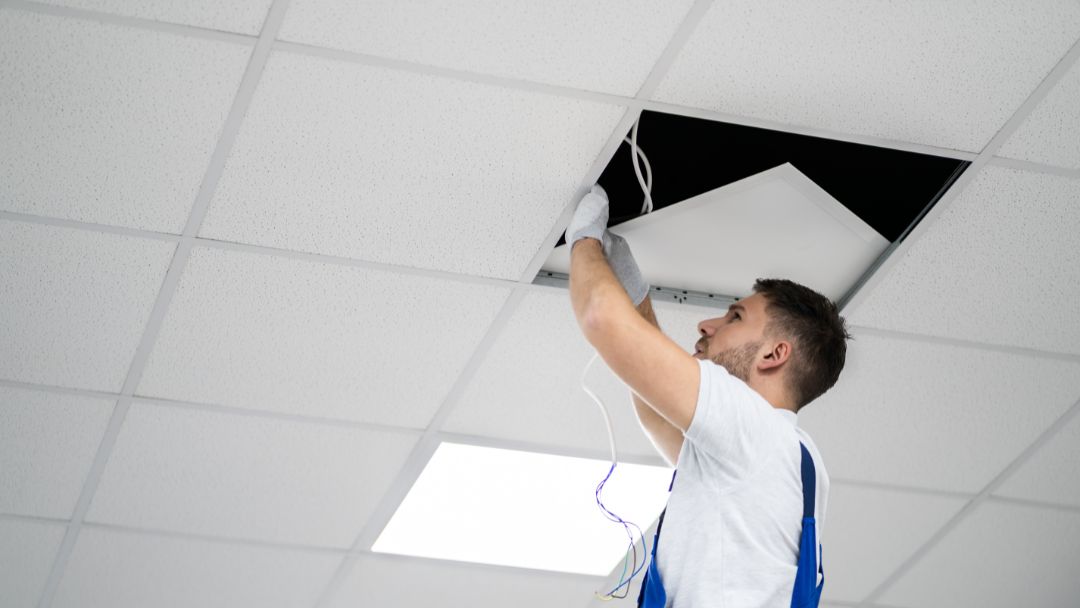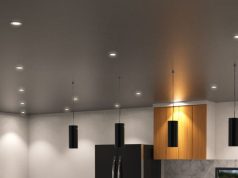Facing Commercial Lighting Issues in Your Business? Let’s Troubleshoot!
Commercial lights are built to withstand higher usage and harsher conditions than residential lighting. But this does not mean that they are safe from the common issues that household lights have. Various factors from the environment, faulty wiring, and improper use can contribute to your commercial lights having problems.
Lighting issues can snowball from merely being annoying to disrupting productivity, compromising safety, and negatively impacting energy efficiency and the overall environment of your commercial space.
This article will assist you in identifying and resolving common commercial lighting problems and help you save money by stopping small issues from escalating to more costly problems. Here, you’ll also know when to get help from a qualified electrician, especially when addressing complex electrical issues. (Hint: You always need professionals to solve electrical problems.)
What’s Wrong with Your Lights? Common Issues and How to Check:
Flickering Lights
The common causes of flickering commercial lights can be divided into two categories: Lighting fixture issues and Electrical issues.
Lighting fixture issue:
- Loose bulb: Check if the bulb is securely fitted.
- Incompatible dimmer: Ensure that the dimmer is compatible with the light source and that the bulb has dimming capabilities.
- Faulty ballast/driver: Consider the age of the fixture and potential ballast/driver failure (requires a qualified electrician).
Electrical issue:
- Voltage fluctuations: Check the power supply/source and the building’s electrical system.
- Loose/faulty wiring: If you’re not certified to work with wiring, get a qualified electrician.
- Overloaded circuits: Check if there are too many appliances or lights connected to a single circuit.
In case of persistent flickering, report to your building management or electrician.
Lights Not Turning On
Possible causes include a power outage, a tripped circuit breaker, a faulty switch, a blown bulb, ballast or driver failure, or a wiring issue.
Troubleshooting this can be done in a step-by-step process:
- Start by checking for a power outage in the area or building.
- Then, check if the circuit breaker is tripped.
- Next, test the switch, but only do so if it’s safe.
- Lastly, inspect the bulb and socket for damage, and replace if necessary.
If the bulb is fine, it could be a ballast, driver, or wiring problem. Get a qualified electrician for the latter.
Dim or Low Light Output
Possible causes are an old or failing bulb, a dirty fixture or diffuser, an incorrect-wattage bulb, ballast/driver issues, or a voltage drop.
How to troubleshoot:
- Replace old and faulty bulbs.
- Clean the dirty fixtures and diffusers.
- Get the correct bulb wattage for the fixture.
- Get a qualified electrician for persistent dimming, faulty ballast/driver, and voltage issues.
Buzzing or Humming Noises
Possible causes of buzzing noises are a faulty ballast (common in fluorescents), loose components, or an incompatible dimmer (for LED lights).
How to troubleshoot:
- For fluorescent fixtures, a buzzing ballast often indicates it’s failing and needs replacement by a qualified electrician.
- Loose components can be fixed. Just make sure the power is off when you do.
- Ensure that you have compatible dimmer switches for LEDs with dimmable capabilities.
- If unsure about all the above points, consult an electrician.
Lights Turning Off Unexpectedly
Fortunately, they’re not ghosts, so there’s no need to get your local church involved.
Possible causes are overheating (especially for older lights), faulty ballast/driver, loose wiring, timer malfunction, and motion sensor issues. The latter two can be directly attributed to intelligent lighting.
How to troubleshoot:
- Review the manufacturer’s guide on overheating. Check if the fixture feels excessively hot.
- For timer and motion sensor issues, check settings for anomalies.
- A failing ballast/driver or loose wiring will likely require a qualified electrician.
Emergency Lights Not Functioning
Possible causes: Flat battery, faulty charging circuit, blown bulb/LED module, wiring issue.
How to troubleshoot:
- Ensure that the emergency lighting system is tested regularly according to UK emergency lighting standards.
- Check if the emergency light is connected to a stable power source.
- Check the battery for loose connections.
- Check if the lights need securing or replacement.
- Test the emergency light using its pre-built test button to simulate a power outage.
- If lights fail during testing or a power cut, the fixture might need inspection and repair by a qualified electrician, preferably specialising in emergency lighting.
When Should You Contact a Professional Electrician for Lighting Issues?
Some minor issues can be resolved with DIY solutions. But persistent problems, such as flickering, dimming, outages, surges, and other significant issues, require professional intervention.
The number one reason to call a qualified electrician for any electrical or commercial lighting repair is safety. First, your safety. Next is the safety of everyone else around you (in a household or a building). Attempts at electrical repairs by unqualified individuals can result in grave injuries, the start of a fire, or even electrocution and death.
Here’s a list of scenarios that require a professional to step in:
- Doubt or discomfort in troubleshooting (for DIY).
- Issues involving wiring.
- Faulty ballasts or drivers (especially if hardwired).
- Repeated circuit breaker tripping.
- Emergency lighting malfunctions.
- Any signs of burning or an electrical odour.
How to Minimise Commercial Lighting Problems in Your Business
Light fixtures, especially LEDs, have long lifespans reaching up to 50,000 hours of lighting time. But without proper care, performance and light output can decline over time, and common problems with LED lighting may appear. That’s why proper maintenance is crucial for prolonging your commercial light’s life.
Here’s an actionable list of things to do to minimise lighting issues:
- Regular cleaning of fixtures.
- Prompt replacement of faulty bulbs/lamps.
- Periodic visual inspections.
- Scheduled professional maintenance checks.
- Upgrading to energy-efficient fixtures (LEDs are generally more reliable).
It’s best to have a regular lighting maintenance schedule if you don’t have one yet. Simple Lighting has a commercial lighting maintenance checklist you can use to make sure you have all your bases covered.
Need Professional Help with Your Commercial Lighting in the UK?
Simple Lighting has a team of lighting experts who can help you navigate the complex ins and outs of commercial lighting. We have a long and proven track record of providing top-notch quality service for commercial lighting projects in the UK.
We’d love to talk to you, so send us a message through our Contact Page, or call us directly at 0333 443 2465. We also have a wide selection of high-quality commercial lights, so if you’re planning upgrades or replacements, make sure to check them out.
Keeping Your Commercial Lights Shining Brightly and Safely
Knowing what to look out for and how to troubleshoot problems with your commercial lights is crucial to avoid outages and a decline in productivity and safety in your business. Knowing how to do troubleshooting for minor issues can help you avoid high repair, maintenance, and professional costs.
Always remember that when unsure and unqualified, get qualified electricians to do the troubleshooting and repairs. It will save you a lot of headaches down the line.















